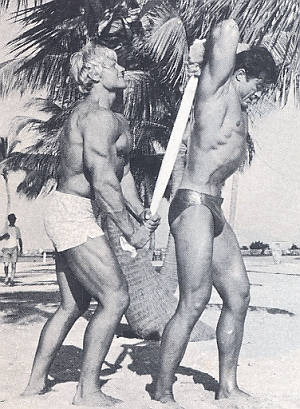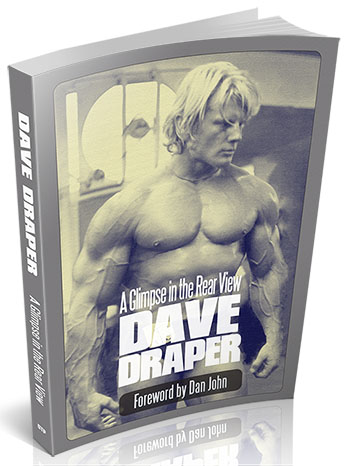You're Fine

Download the full Draper here newsletter
in printable pdf format here.
A muscle-building friend who's near enough to the half-century marker to be slightly confused posed a selection of questions familiar to all of us. The questions are real, valid and daunting. They are particularly concerned with overtraining, training intensity and efficiency, overload, aerobics and muscle mass as the years pass and youth is replaced with middle age. Allow me to generalize, guess and pretend to the best of my recollection. (Accurately.)
First, press on as always. Each day will take us to another threshold. We don't embrace them; we beat them back. Overtraining is a predator on the prowl that will get us if we step into its territory and get us if we don't step close enough. We therefore hang on the ragged edges. This is one of the all-time favorite, fingertip positions where we sort of blow in the winds and gusts, never knowing if we'll be torn away or gain new territory. We take our chances, not tough, cool, stupid, foolish (we're getting close) or desperate. We simply cannot train without intensity if we can train at all.
I believe in maximizing the level of muscle under tension within every workout, utilizing intuition and logic to determine the baffling red line. This is not achieved by the same method or pattern. That is, don't use high reps consistently, though this is popular with me. You could sometimes use near-max weight, though far less often; you might employ slow tempo reps as joint problems are less aggravated and discover an appeal for them as the body grows older.
Static holds on later reps in different ranges of motion should gain your interest for the same reason. They're highly muscle intense, satisfying and promising, whereas in earlier years, I wouldn't let them in the house.
Somewhere I've commented in half a dozen threadbare places that my later training was not unlike my training of years ago: mostly supersetting, pyramiding to mix the reps, singles, doubles, triples staggered over three-week periods, three on-one off, two on-one off, training each muscle group two times a week done at a moderate pace.
The alterations we're willing to make to our semi-flexible parameters reveal themselves day by day. My workouts were always fluid since I stepped out of competition in 1970 -- no less intense, just less rigid. Therefore, in that sense my training principles did not change.
The lesson today: Search each and every workout for the exercises, the combination, the sets and reps, the pace and tempo, the methodology that will allow you to optimize intensity. Maximum intensity may not be registered in every set, but it is in the overall workout. High intensity is sought in every rep, yet adjustments are made to accommodate joint overload, tendon inflammation and its prevention, muscle tear potential and exhaustion of muscle energy stores.
Perceive the workout as the wringing out of a fresh sponge to leave no moisture, yet applying care not to shred its composition. Hence, your growing appreciation for cycles of volume mixed with heavy poundage and the employment of slow-tempo reps and static contractions.
How does this, the outline of a focused training approach, help you answer the inscrutable questions related to overtraining and overload? My bomber attack technique, established early on, had me confronted with the overtraining dilemma for years and has thusly prepared me. You want to train like a horse; you've got to train like a smart horse. No saddle, no bridle -- free. In each workout, with positive thought and high hopes, you warm up, assess your core disposition and proceed toward your most likely target. Put instinct and intuition on alert, feelers ready to approach the edge. Hit it.
There are safer and clearer prescriptions outlined by trainers, coaches and technicians, but none more personally efficient and appealing than muscular finesse. What formulas of percentages prescribed for the workout of the day are more accurate than your own knowing? The development of this ‘knowing' is to be part of your training: diligent practice, attention, trial and error and an unfailing trust in your achievement are the steps.
This is the way to get where you're going if where you're going is the top. Pull back appropriately to accommodate targets less ambitious but no less significant. Getting in shape is a superlative goal and should be approached with artful management.
When it's a question of one more rep or one more set, check the insertions, the duration of the concentric and eccentric motions, the pump and the amount of invested work of the muscle, based on a quick evaluation of sets x reps x weight. An approximation of this workout input compared to your last workout input, plus considerations of sleep, feeding and non-workout workloads should give you the clues to how to move forward, stop or retreat.
Cut back on the reps and finish the sets, hold back on the weight and complete the sets with form and slower tempo. Get the prescribed sets and slow the pace. Other options are available by the modification of the variables. Your choice, chief.
A burdened and shoulder-weary depression might require that you forego your aerobic and mid-section activity (or sometimes it's the opposite). Aggressive, direct action without delay will provide a psychological advantage and reserve energy stores for the muscle work ahead. Set yourself squarely before your taskmaster and apply yourself to the nudging of the weights. This is a test, a sounding of the ground, the locating of the wind as if by moistening your finger and holding it to the air. The first set of a light weight with a smile and slow reps with a stretch often open the creaking doors to a wonderful workout, a workout of grand proportions where inspiration plays host, and personal records are sometimes set.
If you discover resistance persists and a change in course fails, gather your things and head home for solace, food and rest. You're fine. You're growing. Be thankful.
Aerobic training has its place in conditioning, improving heart and respiratory health, energizing, detoxifying and warm-up. A conditioned musclebuilder who participates in highly evolved volume training and is no slug on the gym floor can wisely put the activity on the shelf and reserve it for super conditioning or for those times when weight training due to injury, overtraining or burnout is not the practical scheme to follow. Extended aerobics, cross training combined with mid-section and wind sprints are smart and tough alternate training styles to develop for overall body ability, flexibility, stamina and the occasional variation.
Don't let anything surprise you or short-circuit your plans. Of course, getting older is no one's favorite pastime and adjusting to the compromises is not eagerly done. Recovery, strength and flexibility do not sky rocket with age, yet attitude and disposition will make up where the others falter.
Start with plenty of rest and good food.
Bombs away...DD
*****
Take a trip over to our
Musclebuilding Q&A Blog
... where Dave allows us a peek into his email outbox.
Did you sign up for Dave's expanded email yet?
It's free, motivating and priceless!
We'll also send you a link to Dave's free
Body Revival Tips and Hints e-report with your confirmation notice.

